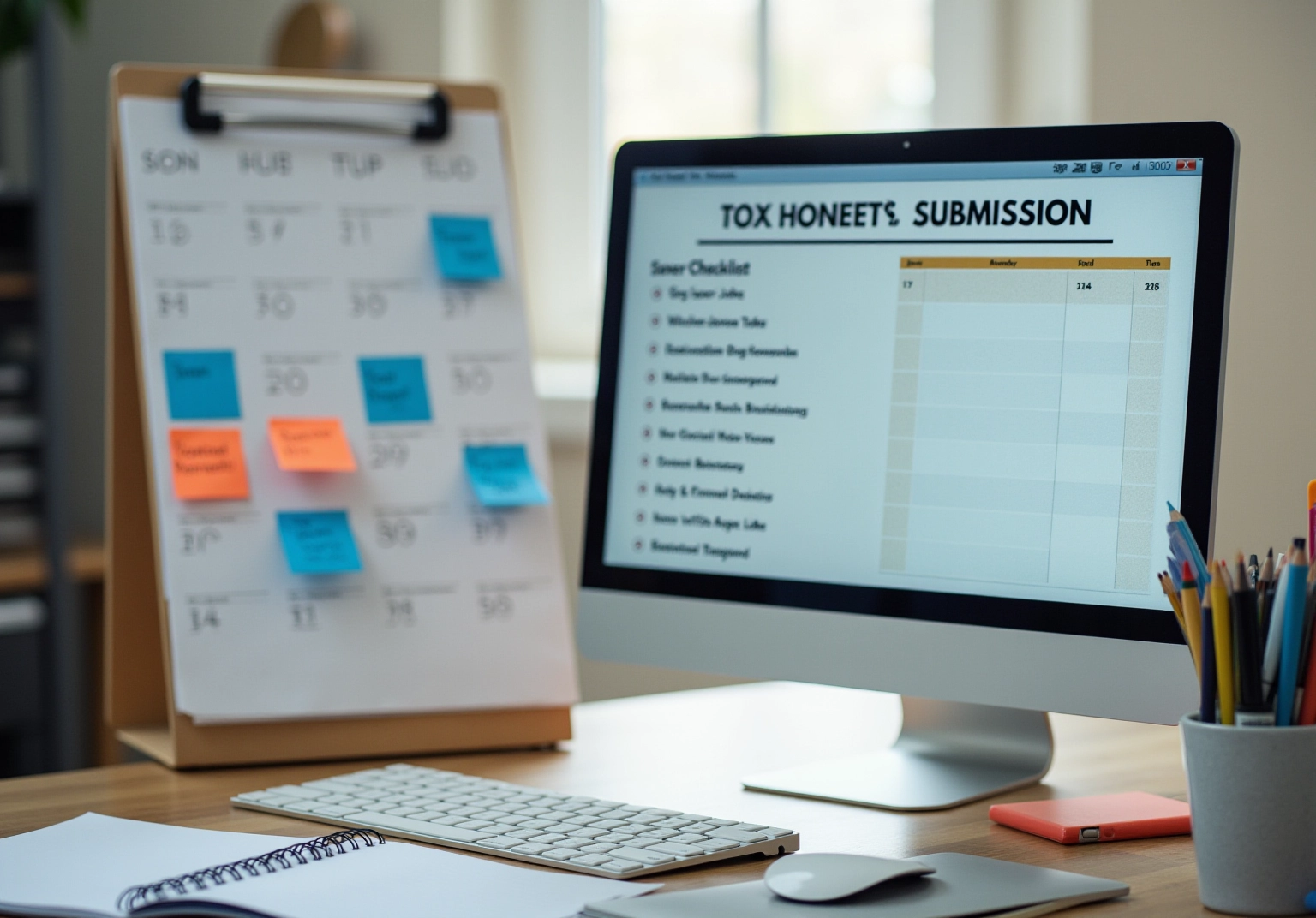Overview
The article presents a compelling five-step checklist designed for tax preparers, aimed at enhancing client interactions and streamlining the document collection process. By highlighting the critical importance of:
- Gathering essential documents
- Establishing clear communication
- Setting submission deadlines
- Leveraging technology
it effectively illustrates how these practises culminate in improved efficiency and heightened client satisfaction in tax preparation. This approach not only addresses the current challenges faced by tax professionals but also underscores the transformative impact of adopting these strategies.
Key Highlights:
- Request essential documents from clients, including tax returns, W-2s, 1099s, and receipts for deductions.
- Create a checklist to ensure all required documents are collected for tax preparation.
- Use secure file-sharing services to enhance document submission security and efficiency, resulting in improved customer response rates.
- Implement automated reminders to prompt clients for timely submission of paperwork, improving workflow efficiency.
- Verify client information accuracy by cross-referencing with previous tax returns and utilising automation tools to reduce errors.
- Establish clear communication channels for tax inquiries and inform clients about preferred methods and response times.
- Set clear submission deadlines for documents and encourage early submissions to enhance quality and reduce last-minute pressure.
- Utilise technology, such as client portals, to centralise communication and document tracking, improving organisation and efficiency.
Introduction
Navigating the complexities of tax preparation can be daunting for both clients and tax preparers alike. A well-structured tax preparer checklist not only streamlines the process but also enhances client satisfaction by ensuring that all necessary documents are gathered and verified accurately. However, with the rapid evolution of technology and shifting client expectations, how can tax professionals adapt their strategies to meet these challenges head-on and foster effective communication? This article delves into five essential steps for tax preparers, offering insights that can transform the client experience and optimise the efficiency of tax preparation in 2025.
Gather Essential Client Documents
Gather Essential Client Documents
Request the following documents from clients:
- Previous year’s tax return
- W-2 forms from employers
- 1099 forms for freelance or contract work
- Bank statements and investment income statements
- Receipts for deductible expenses
- Any relevant financial statements
Create a comprehensive checklist of required documents to share with clients, ensuring that nothing is overlooked during the tax preparation process.
Employ a secure portal, such as a file-sharing service, to enable efficient submission and storage of files. This method not only improves security, including GDPR adherence, but also simplifies the collection process, enabling accountants to gather customer feedback in half the time relative to conventional email techniques. Companies utilising the platform have seen a 40% rise in customer response rates and a 50% decrease in response times, emphasising its effectiveness in enhancing collection efficiency.
Set up automated reminders to encourage customers for prompt submission of paperwork. The adaptable automated reminder function of Glasscubes permits personalised scheduling and messaging, ensuring that users are prompted suitably to meet deadlines. Firms utilising such reminders have reported significant improvements in workflow efficiency.
Stay informed about current trends in submission for accountants in 2025, as the integration of technology continues to reshape the landscape. With 49% of accounting tasks being fully automatable, leveraging these advancements can lead to increased client satisfaction and operational effectiveness. To keep up with these trends, consider subscribing to industry newsletters, attending webinars, or joining professional accounting associations.

Verify Client Information Accuracy
Ensure the accuracy and consistency of client-provided information by using a tax preparer checklist for clients to cross-cheque it against previous tax returns and documents. To prevent potential errors that could lead to costly mistakes, confirm essential personal details, such as Social Security numbers, addresses, and filing statuses, included in the tax preparer checklist for clients.
Leverage advanced software tools to automate data verification, significantly reducing manual errors and enhancing efficiency. Despite the fact that only 37% of accountants currently utilise such automation, a striking 89% acknowledge its time-saving potential.
Encourage clients to meticulously review their information for accuracy before submission by utilising the tax preparer checklist for clients; this crucial step can prevent significant financial repercussions.
Notably, companies utilising platforms like Glasscubes have reported a remarkable 40% increase in customer response rates and a 50% decrease in response times, thanks to features such as automated reminders that ensure organised communication and prompt follow-ups.

Establish Clear Communication Channels
Establish dedicated communication channels, including email, phone, and a customer portal, specifically tailored for tax-related inquiries, as part of a tax preparer checklist for clients. This approach ensures that customers clearly understand where to direct their inquiries and concerns.
It is imperative to inform customers about preferred communication methods and expected response times, thereby setting realistic expectations and enhancing transparency.
Leverage the automated messaging functions available in platforms like Glasscubes, which provide real-time insights into the status of requests and dedicated onboarding support. This functionality keeps customers informed about their document statuses and impending deadlines, streamlining communication and significantly reducing the time accountants spend on follow-ups. Companies utilising Glasscubes have reported a remarkable 50% reduction in response times alongside a 40% increase in customer interaction, thereby enhancing overall engagement through secure, encrypted, and GDPR-compliant processes.
Arrange frequent cheque-ins throughout the preparation process to review the tax preparer checklist for clients and address any questions or concerns that individuals may have. This proactive strategy fosters trust and sustains customer engagement.
Case studies reveal that firms implementing dedicated communication channels and automated messaging have experienced substantial improvements in customer satisfaction, including an impressive 288 hours saved during a single tax season. By optimising workflows with tools like Glasscubes, accounting firms can significantly enhance their efficiency and strengthen customer relationships.

Set Submission Deadlines for Documents
Effectively communicate submission deadlines to customers while taking into account the overall timeline outlined in the tax preparer checklist for clients. A well-defined timeline empowers customers to understand the critical nature of timely submissions.
Leverage calendar tools to establish reminders for both you and your customers regarding impending deadlines. Glasscubes’ automated reminder feature enables you to dispatch up to 10 reminders on a straightforward schedule, or an unlimited number with advanced options, ensuring that everyone remains informed and ready.
Encourage customers to utilise the tax preparer checklist for clients to submit materials well in advance of the deadline, allowing for any necessary adjustments. This proactive approach not only alleviates last-minute pressure but also improves the quality of submissions.
Monitor submissions through your secure and user-friendly customer portal, which accommodates unlimited requests and storage, guaranteeing that all files are received on time. A centralised platform enhances communication and reduces the likelihood of overlooked documents.
Provide consistent updates and reminders about deadlines, underscoring their significance. Regular communication fosters accountability and boosts customer compliance. Companies utilising this platform have experienced a 40% increase in customer response rates and a 50% reduction in response times, highlighting the efficacy of this approach.

Utilize Technology for Efficient Information Gathering
Create a user portal akin to Glasscubes that centralises file gathering and communication, ensuring all correspondence is included within each audit request. This innovative approach eliminates the chaos of email threads, providing a well-structured list of pending items and associated queries.
Automated notifications will serve as reminders for any absent documents or information, featuring adjustable scheduling and messaging options that convey urgency for impending deadlines.
Leverage real-time reporting capabilities to track the status of client submissions, enabling clear visibility of outstanding requests and significantly reducing the time spent searching for information.
Equip your team with the necessary training to utilise this technology effectively, maximising its benefits in the tax preparation process. This ensures that everyone remains informed and can manage responses efficiently.

Conclusion
The significance of a comprehensive tax preparer checklist for clients is paramount. By adopting a systematic approach that includes gathering essential documents, verifying information accuracy, establishing clear communication channels, setting submission deadlines, and leveraging technology, tax preparers can markedly enhance their efficiency and client satisfaction throughout the tax preparation process.
Key strategies highlighted throughout the article underscore the necessity of collecting vital client documents, ensuring accuracy through verification processes, and fostering transparent communication. The integration of technology—such as automated reminders and secure portals—emerges as transformative, streamlining workflows and improving response rates. Each of these steps is critical in mitigating errors and ensuring timely submissions, ultimately leading to a more seamless tax season.
As the landscape of tax preparation evolves, embracing these best practises is essential for success. Tax preparers are urged to adopt these strategies not only to meet current demands but also to prepare for future trends within the industry. By prioritising organisation, communication, and technology, tax professionals can enhance their operational effectiveness and cultivate lasting relationships with their clients, ensuring a positive experience year after year.
